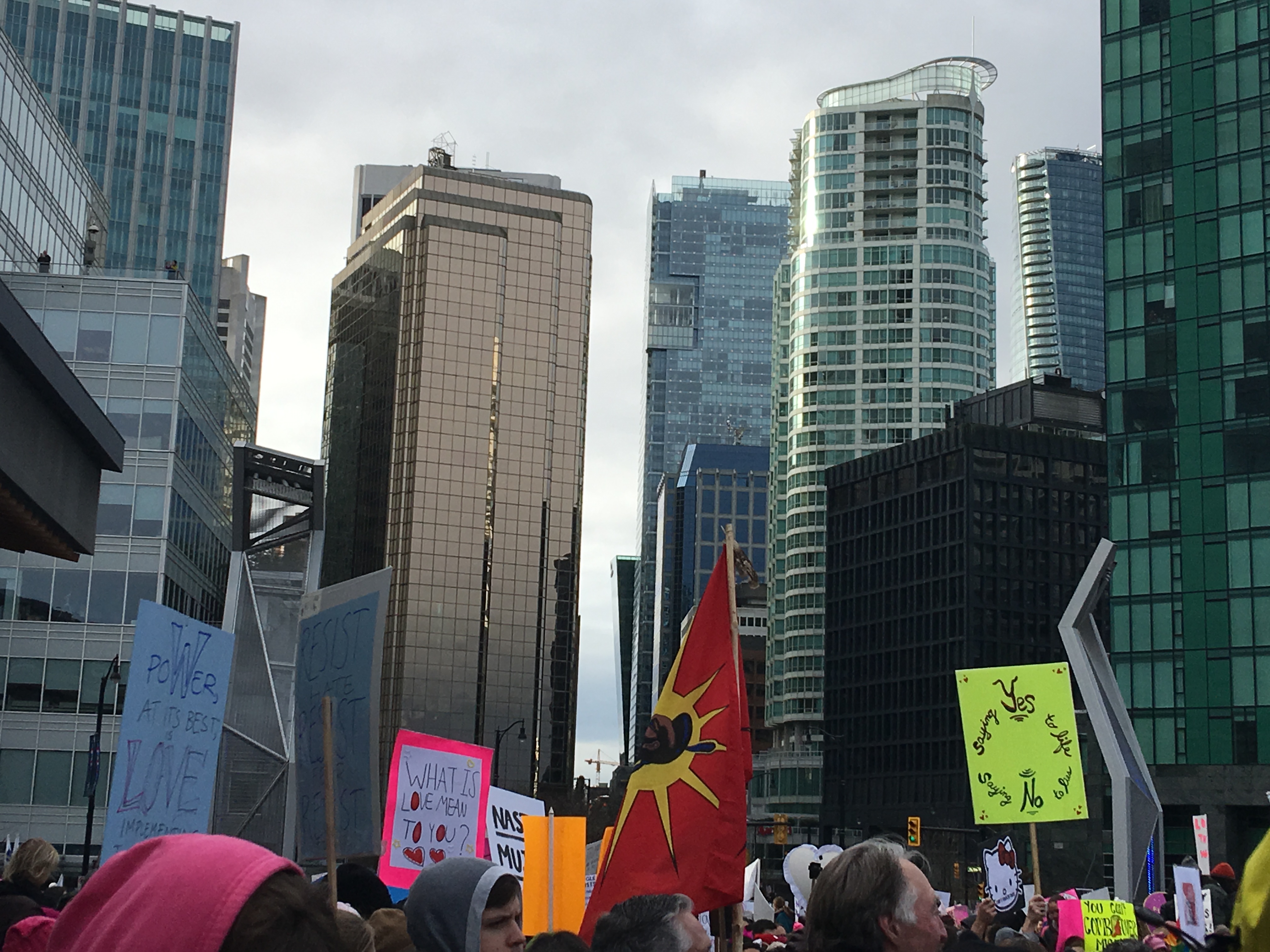Solidarity Through Difference
This image shows the Mohawk Warrior flag held up by Native demonstrators at a women’s solidarity march in Vancouver on January 21, 2017. The march was held alongside many other women’s marches all over the world in order to assert women’s rights and civil liberties and to protest against the racism, sexism, homophobia and bigotry of the recently inaugurated U.S. President Donald Trump, and more broadly, the prevalence of these oppressive ideologies worldwide.
The Mohawk Warrior flag depicts a Native with a Mohawk haircut on a bright yellow sun against a red background, and is often carried at Native protests. The Mohawk man represents the Kanien’kehá:ka men of the Rotinonhsón:ni, who are known for being ready to protect the rights of their peoples and their land (“The Warrior Unity Flag”, 2012). In this context, the flag stands for resistance against the infringement upon the rights of Native women in particular. The flag asserts Native rights in response to how racism and sexism intersect and serve to marginalize Native women.
Globally, in many predominantly white societies, women of color are sidelined in feminist movements due to the perception that a woman’s gender oppression should be the single focus of feminist struggle. This excludes other forms of injustice that perpetuate inequalities across women worldwide. Locally, Native women experience incredible racism, reinforced through years of settler colonialism, which adds to the sexism they experience to create horrible, violent realities. For example, according to the Native Women’s Association of Canada, Native women are 3 times more likely to be killed by a stranger than non-Native women (2015). Their abandonable status is reflected through the half-hearted investigations following their deaths, which are justified through both racialized and gendered tropes, such as the portrayal of these women as prostitutes or drug addicts.
White feminists cannot simply play “host” and invite women of color as “guests” into the feminist movement, as they often have done (hooks, 1984). It is important to think about how oppression is defined worldwide, and by whom. Oppression occurs when differences between individuals, such as gender or race, are overlain with power, which leads to social differentiation and the creation of privilege. This can be seen not just across the male-female dynamic but also between women. The fight of feminism must therefore include the fight against these multi-layered oppressions, as until this is realized, there are many women who will not be free. To simply welcome women of color to join the feminist movement on the basis that they are oppressed by men erases the complicity of white women in perpetuating the oppression of these women. Solidarity marches often emphasize sameness and togetherness for fear of compromising the feminist movement, but perhaps this should be re-evaluated in favor of acknowledging real differences along power lines.
The Mohawk Warrior Flag as an assertion of Native culture also reflects resistance against the enduring erosion of Native culture by European settlers. Many women and women supporters at the solidarity marches, not just in Canada but worldwide, protested against the imperialist mindset of U.S. President Donald Trump, who advocates for the subordination of groups of individuals based on perceived notions of American economic, cultural, religious and territorial superiority. This global anti-imperialist struggle assumes a local significance in Canada, given the history of dominance of European colonial settlers over Natives. The key to this domination is the concept of anachronistic space, the idea that the further one gets from the colonial center, the more regressive a society must be. This concept thus necessitates a colonial civilizing mission that seeks to erase Native culture and replace it with a more progressive, civilized European culture (Alvarez, 2006). This has been practiced over the years with legal restrictions on Native culture, such as the banning of cultural practices, as well as the forced enrolment of Native children in Residential Schools in order to impose a “superior” Eurocentric curriculum on them.
These historical practices were met with much Native resistance, which continues today in response to the silencing of Native voices and the enduring effects of the past, of which the presence and protest of Native women and men at the solidarity march are a powerful example. (688 words)
References
Alvarez, Claudia. (2006) Humanism after colonialism. Switzerland: Peter Lang.
Warrior Publications. (2012, March 18). The warrior/unity flag [Blog post]. Retrieved from https://warriorpublications.wordpress.com/2012/03/18/the-warriorunity-flag/
Native Women’s Association of Canada. (2015). Fact sheet: Missing and murdered indigenous women and girls [Data file]. Retrieved from https://www.nwac.ca/wp-content/uploads/2015/05/Fact_Sheet_Missing_and_Murdered_Aboriginal_Women_and_Girls.pdf
hooks, bell. (2015). Feminist theory: From margin to center. New York, NY: Routledge.
